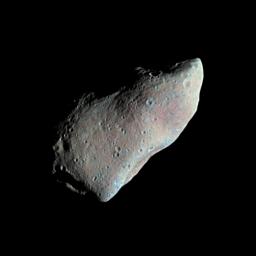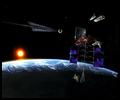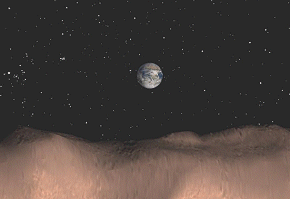
NASA -- larger image
Stoney asteroid,
951
Gaspra
(more
information
and
orbit).
Near-Earth asteroids and comets may be economical sources of raw materials for large space construction projects, as it should take comparatively little effort to move them (or semi-processed materials) within range of space-based industrial operations.

Space Studies Institute
(SSI)
Larger image
While asteroids are rich in the metals and minerals needed for needed for building space facilities, comets are rich sources of the water and carbon-based molecules needed to maintain life. According to John Lewis (a University of Arizona planetary scientist), for example, the smallest Earth-crossing asteroid 3554 Amun (see orbit) is a mile-wide (2,000-meter) lump of iron, nickel, cobalt, platinum, and other metals; it contains 30 times as much metal as Humans have mined throughout history, although it is only the smallest of dozens of known metallic asteroids and worth perhaps US$ 20 trillion if mined slowly to meet demand at 2001 market prices. Moreover, water ice in comets can be converted to liquid hydrogen and oxygen, two of the primary ingredients in rocket fuel today. Thus, some believe that that, as we begin to colonize the inner Solar System in this new millenium, NEAs will become convenient sources of the raw materials needed for building space habitats while NECs will become vital "watering holes" and gas stations for interplanetary spacecraft.
|
|
|
|
|
| Iron
91%
Nickel 8.5% Cobalt 0.6% Sources: Encyclopaedia Britannica, space.com, and the Space Studies Institute. |
Oxygen
36%
Iron 26% Silicon 18% Magnesium 14% Aluminum 1.5% Nickel 1.4% Calcium 1.3% |
Oxygen
49%
Silicon 26% Aluminum 7.5% Iron 4.7% Calcium 3.4% Sodium 2.6% Potassium 2.4% Magnesium 1.9% |
Oxygen
42%
Silicon 21% Iron 13% Calcium 8% Aluminum 7% Magnesium 6% Other 3% |
Earth Trojan Asteroids
There may be asteroids trapped around 60 degrees ahead and behind the Earth within its orbit as it moves around the Sun. Known as Trojan asteroids, these objects have been found in corresponding locations within the orbits of Jupiter (orbit diagram) and Mars. Earth and Mars Trojan asteroids (as well as the two moons of Mars, Phobos and Deimos) would be good candidates for industrial exploitation because of their proximity to large space facilities and habitats proposed for Earth or Mars orbit.

NASA -- larger
and
jumbo
images
Mining
ship prepares to leave orbit
for an Earth-approaching asteroid.
Near-Earth Objects (NEOs)
NEOs are asteroids and comets that have been nudged by the gravitational pull of nearby planets into orbits that cause them to enter the Earth's vicinity. In terms of orbital elements, NEOs are asteroids and comets with a perihelion (q) distance less than 1.3 times the Earth-Sun distance (AU). Near-Earth Comets (NECs) are further restricted to include only short-period comets -- that is, with an orbital period (P)less than 200 years.
 NEAR, APL, and
NEAR, APL, and
Johns Hopkins University
Flyover of
433
Eros
-- and rotating.
See
orbit
diagram,
a NASA
news
brief,
and more
animations
and videos.
However, the vast majority of NEOs are asteroids, called Near-Earth Asteroids (NEAs). NEAs are subdivided into the Aten, Apollo, and Amor groups (that are categorized by their perihelion distance (q), aphelion distance (Q), and their semi-major axes (a) of orbit) and the Potentially Hazardous Asteriods (PHAs). PHAs are objects that can some day harm life on Earth because of their proximity and size -- Minimum Orbit Intersection Distance (MOID) with the Earth is 0.05 AU or less with an absolute magnitude (H) of 22.0 or brighter.

NASA
Larger and
"peanut" images,
and
orbit
diagram
Composite radar image of
4179
Toutatis and Earth.
One of the largest known PHAs is Toutatis, an asteroid that is nearly a mile (1.6 km) long. No other PHA larger than 0.6 miles (one km) has been found that moves around the Sun in an orbit so nearly coplanar -- inclined less than half a degree -- with Earth's, extending from just inside Earth's orbit to a point deep within the Main Asteroid Belt between Mars and Jupiter. On September 29, 2004, Toutatis will pass just four Lunar distances from Earth, which is closer than any other known PHA over the next 30 years. (See NASA article for more information.)